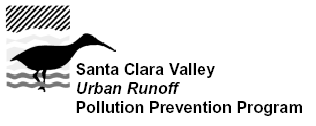Stormwater Runoff
- Vehicle Brake Pads
- Architectural Copper
- Pool/Spa/Fountain Algaecides
- Copper Pesticides
- Industrial Copper Use
- Soil Erosion
- Mobile Cleaning
- Vehicle Washing
- Vehicle Services
Discharges to POTWs
Shoreline Activities
Architectural Copper
As reported by the Copper Development Association, the architectural use of copper has increased in recent years. However, copper roofs and gutters cost far more than ordinary materials. As a result, a relatively small number of structures in the San Francisco Bay area use copper. The City of Palo Alto estimated that copper roofs are installed on 0.05 percent of the City's residences, 0.3 percent of industrial commercial buildings and 1.5 percent of other structures.
Stormwater Control Measures
Following a series of studies that indicated high concentrations of copper in copper roof and gutter runoff, the City of Palo Alto commissioned a study to estimate copper releases to stormwater from copper architectural features. The results are summarized in the report entitled "Architectural Uses of Copper: An Evaluation of Stormwater Pollution Loads and BMPs" (March 2001). Possible control measures included coating copper to reduce releases treating runoff to collect released copper, public education to reduce copper use, and restricting copper use.
Palo Alto determined
that the most effective control approach was to adopt an ordinance prohibiting
the use of copper-containing roofing materials, shingles, and gutters
in new buildings, and prohibiting their use for replacement of roofs except
in historic buildings. The practicality and efficacy of control measures
such as coatings and runoff treatment to prevent copper releases from
roofs or to remove copper from roof runoff have yet to be determined.
A few municipalities in the San Francisco Bay area have implemented public
education and outreach measures to limit use of copper architectural features.
Wastewater Control Measures
The release of copper from architectural features to a Publicly-Owned Treatment Works is unlikely to occur.
Best Management Practices
Sources of best management
practices and general information relating to architectural copper include:
California
- Palo Alto Ordinance Prohibits Copper Roof Materials - This one-page fact sheet prepared by the City of Palo Alto discusses the impacts of architectural copper on stormwater pollution and provides the City's ordinance prohibiting copper roofing materials.
- Palo
Alto RWQCP- Architectural Uses of Copper: An Evaluation of Stormwater
Pollution Loads and BMPs - This detailed report presents an "order-of-magnitude"
estimate of the amount of copper released from roofs and other architectural
features in the Palo Alto RWQCP service area, and compares that release
with the amount of copper measured in local streams. The feasibility
of various best management practices for reducing or treating copper
roof runoff is evaluated.
